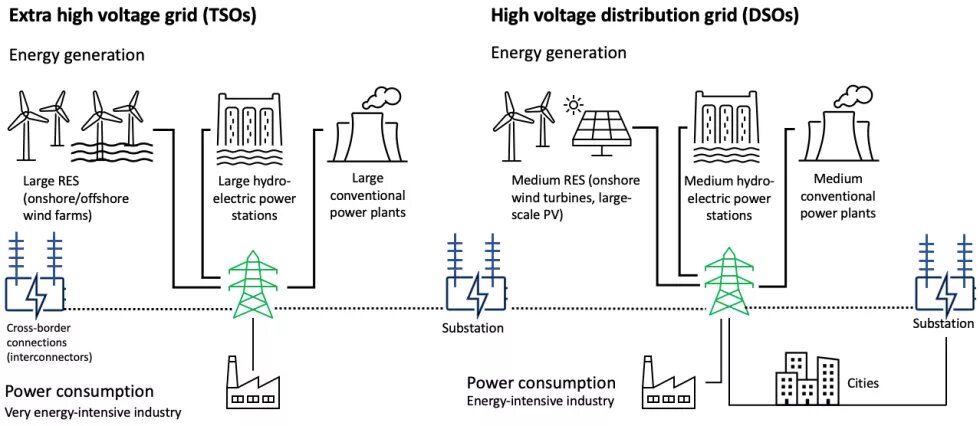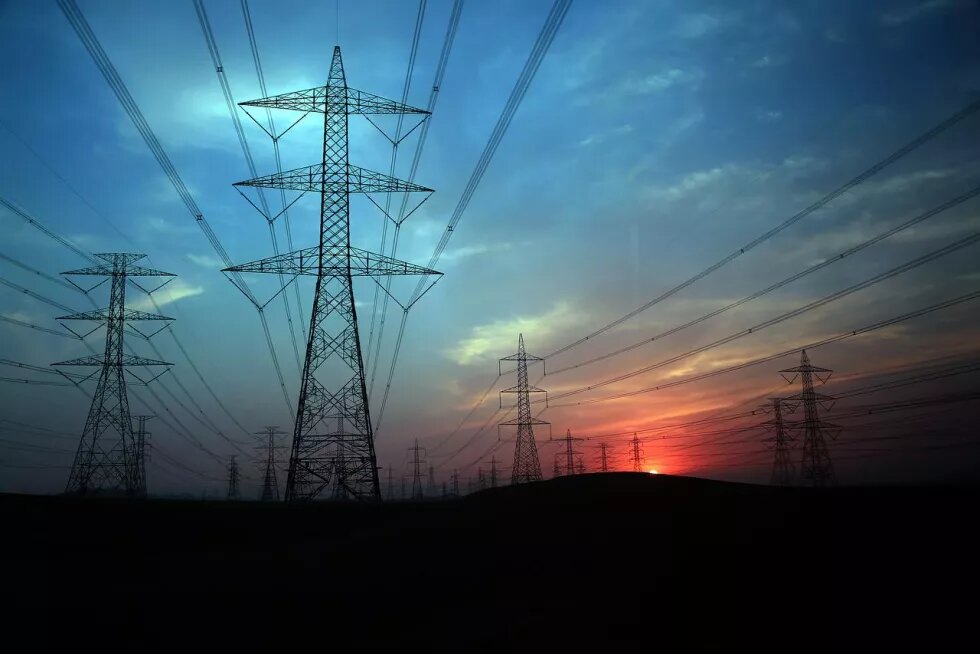
Since the end of the 19th century, an uninterrupted energy supply has been the driving force behind the growth of the world's largest economies. For modern societies, electricity is an inextricable part of life. This explainer provides a “bigger picture” of the grid system and highlights the role it plays in the sustainable transformation of our economies and societies. It presents grid development in the context of the entire energy transition, outlining its specific components and challenges, and providing examples of measures that address these challenges.

Introduction
Since the end of the 19th century, an uninterrupted energy supply has been the driving force behind the growth of the world's largest economies. For modern societies, electricity is inextricable part of life: whenever we wish to use our appliances, be it computers, mobile phones, refrigerators, or vacuum cleaners, we can simply plug them into a socket in the wall to power or charge them. An interruption of electricity supply can cause enormous social and economic damage, as the recent example of the Texas blackout in February 2021 has shown. To make sure that electricity is delivered to our homes, offices, schools, and hospitals in a stable and reliable way, it must be transported from the point of generation to the point of consumption. This happens via electricity transmission and distribution lines, which are the backbone of the energy system.
The electric grid system, referring to the network by which electricity is delivered from producers to consumers, is an essential element of the energy transition, by which the global energy sector is gradually transitioning from fossil-based to zero-carbon. By enabling the integration of electricity generated from renewable energy sources (RES) into the general electricity supply, it contributes to the decarbonization objectives outlined in the Paris Agreement. Nevertheless, developing new power lines and the accompanying infrastructure is not always easy. It can cause controversies related to locally contextualized constraints (e.g., landscape concerns, effects on tourism, or property value issues), which can lead to a lack of public acceptance, as illustrated by cases from Germany, Norway and Spain.
Considering the complexity of the electric grid system, it is important to understand its diversified facets. This explainer aims to show a “bigger picture” of the grid system and highlight the role it plays in the sustainable transformation of our economies and societies. It presents grid development in the context of the entire energy transition, outlining its specific components and challenges, and providing examples of measures that address these challenges.
Background: Energy Policy Goals and Drivers of the Energy Transition
The planning, development, and operation of electricity transmission and distribution infrastructure is deeply embedded in the entire energy system’s development. The grid system is subject to processes and policies that define and regulate the energy sector and its transformation. For many years, the general direction of the energy system’s development was pre-determined by key energy policy goals: Securing energy supply, limiting the environmental burden, and guaranteeing competitiveness and economic efficiency.
Security of supply means that the demand for energy is always supplied sufficiently and without interruption. With regard to the grid system, this means that suitable network must exist to transport electricity from the generation units to all places of demand, and that electricity reserves must be stored in the network and at the power plants. Expanding the power grid and integrating transnational electricity systems can strengthen security of supply by enabling generation and load peaks to be balanced across borders. The integration of transnational electricity systems helps to keep power outages to a minimum and is thus instrumental in safeguarding the system from blackouts.
Limiting the environmental burden refers to resource conservation and other sustainability considerations, ranging from local and regional aspects of environmental protection to the global challenge of climate change. A political goal to limit the environmental burden of energy generation, transmission, and distribution, requires a transformation towards energy sources that do not emit green-house gases or cause other environmental pollution, while maintaining an ecologically sensitive approach to energy infrastructure planning and development.
Economic efficiency relates to a cost-optimized energy system that guarantees universal access to reliable, affordable, and abundant energy for domestic and commercial uses.
Sometimes the combination of the above-mentioned goals has been called an “energy trilemma,” reflecting the potential synergies and trade-offs between them. Recently, this concept has been enriched by an additional element – justice – to underline the importance of addressing social issues when implementing energy transition to make it more democratic. These social aspects relate to a number of considerations, including fair division of costs and benefits between different social groups (sometimes called just transition), intergenerational equity, and global justice, emphasizing the international interdependencies of the modern energy systems.
While the development and maintenance of the grid system needs to be aligned with the energy policy objectives described thus far, the electricity network system is also significantly impacted by other changes experienced by the modern energy system, particularly in relation to decentralization and digitalization. This interrelation also works conversely: The massive transformation towards a decentralized and digitalized energy system would not be possible without transmission and distribution electricity lines. Subsequent sections explain the role of the grid system in energy transition and the challenges related to its development in the context of the drivers of the energy transition and the fulfilling of energy policy goals.
The Role of the Grid System in Energy Transition
The energy transition requires a shift from fossil-fuel based energy systems to renewable energy sources. Yet the deployment and connection of decentralized solar and wind installations is a complex process, as RES-based electricity generation is often geographically displaced from where the power demand is concentrated. Moreover, such generation is not steady and ongoing, but rather, depends to a large extent on changing weather conditions, such as sunny skies or potent winds.
Power lines and substations enable the transport of electricity from power production points to consumption sites. Extra-high voltage (220 or 380 kilovolts (kV)) transmission grids transport large quantities of electricity from large renewable energy production facilities (e.g., onshore, and offshore wind farms or large hydro-electric power stations) and conventional power stations across long distances. They also connect the electricity systems of neighboring countries and enable electricity to be exchanged transnationally. These extra-high voltage “electricity highways” are managed by transmission system operators (TSOs). Electricity flowing via extra-high voltage lines can be delivered directly to very energy-intense demand centers, such as steelwork industrial units, but more often it is transferred to lower voltage levels for further distribution.
The highest of these distribution levels is called ‘high voltage.’ This type of grid (110 kilovolts) brings electricity to cities, supplies the majority of the industrial sector and while it is usually managed by regional distribution system operators (DSOs), in some countries the TSOs also take responsibility for this voltage level. The medium voltage distribution grid (usually 3, 6, 10, 15, 20, 30 kilovolts) supplies industrial and commercial sectors. The electricity is distributed to the regional transformer substations or directly to larger facilities, such as hospitals and factories. The low voltage distribution grid (less than 1 kilovolt, usually 230 or 400 volts) is intended for local distribution. It provides electricity to private households, smaller industrial companies, trades, and public facilities. The four levels of the electricity grid are illustrated in Figure 1.
Guaranteeing a stable, reliable, and affordable electricity supply can only be achieved via fair, transparent, and sustainable grid development. However, the realization of this objective is beset by specific challenges and requires the implementation of tailored solutions and approaches.
Source: Author’s own elaboration based on the materials provided by 50Hertz
Challenges of Grid Development and Selected Corresponding Measures
To plan, develop, and operate the electricity grid, transmission and distribution system operators (TSOs and DSOs) need to comply with specific rules and legislation set by the planning, permitting, and implementing authorities. In European countries, the main actors are the independent National Regulatory Authorities (NRAs), which set the main rules for grid planning and oversee the electricity market. For example, they approve new power line projects based on cost-benefit analyses and impact on socio-economic welfare. NRAs also decide on price components paid by electricity consumers to finance the past and future costs of building and operating the electricity grid (network tariffs).
However, the activities of TSOs and DSOs are anchored in multi-level settings, including being constrained by specific regulations required by regional and local authorities. Moreover, grid development ideally should also take into account multiple needs and concerns of various stakeholders, ranging from environmental NGOs and nature conservationists to local civil initiatives, and specific social groups, such as farmers, fishermen and hunters.
Fulfilling many legislative requirements and accommodating different, sometimes opposing, interests is a challenging task on many levels. The three main dimensions of grid development are: technical, environmental, and social. These dimensions do not function in isolation from each other but are interconnected and reflect the overall complexity of modern energy systems.
The technical dimension of grid system development and operation focuses on future technological aspects, such as smart and digital solutions to increase RES integration. These aim to provide more stability to the electricity system, balancing the grid, connecting different energy sectors, and making the system more flexible. Considering the complicated nature of such activities, close collaboration between TSOs and DSOs is essential for their success. In addition, the technical dimension covers solutions related directly to infrastructural innovations, such as new technologies for underground cables and hybrid interconnectors.
From an environmental perspective, building electricity transmission and distribution infrastructure to integrate RES supports decarbonization. However, this infrastructure can result in negative environmental effects, such as bird mortality from collision and electrocution. To counteract this, grid operators and other actors develop nature and biodiversity protection measures, which aim at avoiding or reducing the impacts of grids on the environment. For example, these can encompass ecosystems’ enhancement under overhead lines, as in the case of Integrated Vegetation Management, or creating the information basis for bird protection measures, such as an online data collection portal. TSOs also undertake environmental protection measures in marine ecosystems, for example, by implementing nature-friendly technological solutions for installing marine cables, or restoring large-scale degraded marine areas.
The social dimension relates to the effects that electricity grid projects can have on local communities and the ways in which to minimize or compensate for them. It is also connected to the features of decision-making processes conducted by the project developers and the way in which they involve local citizens and other stakeholders. In that sense, TSOs have developed different forms of compensation, for example, to build or improve public space and community infrastructure or sometimes even provide remuneration to individuals as a form of proximity payments. Grid developers also endeavor to design approaches that enable closer engagement and collaboration with stakeholders, recognizing their needs and responding to societal expectations in an innovative manner. These activities encompass early communication about a project’s planning and development, and providing transparency regarding the steps involved in order to cultivate mutual trust between all participants of this process. This can be realized via the development of an online participation platform, application of novel engagement tools, providing a mobile citizen’s office, or even producing educational materials for schools.
What to Expect Next: Electricity Grids for Sustainable, Smart, and Inclusive Energy Transition
The accelerating climate change severely affects societies and economies around the world and deep decarbonization is a must to avoid climate change effects such as flash floods, prolonged droughts, tornadoes and uncontrollable wildfires. The sustainable transformation of energy systems, based on RES, is essential for achieving this goal. Promoting the deployment of renewable energy sources will advance further decentralization, digitalization, and democratization of our energy systems. That electricity grids will be key enablers of this transition is reflected in at least three observable developments.
First, the ongoing expansion of offshore energy generation, predominantly wind, brings promising opportunities to accommodate higher amounts of renewable electricity. To accommodate this expansion, not only are new marine cables needed to connect the electricity generation facilities on our seas and oceans with substations on the shore, but also, new technological solutions are necessary to reduce costs and improve the efficiency of the power supply.
Furthermore, the latter objective goes hand in hand with improving the energy system’s reliability, flexibility, and optimized use of resources. Electricity grids can support all three of these attributes by smartly connecting different actors and users and coordinating supply and demand in real time. Digital solutions utilized within the grid system will gain significance, especially due to the trend of advancing electrification of all energy sectors and their integration, e.g., by connecting distributed appliances, such as heat pumps or electric vehicles.
Finally, in an optimal scenario, citizens will continue becoming more empowered and active actors of the energy transition. More people will switch to e-vehicles, install solar panels on their rooftops and become prosumers, consuming electricity that is self-produced. The growing number of different forms of energy communities, and their accompanying business models, will require grid development to stabilize the network and to enable electricity trading between the neighbors.
While these processes are expected to gain speed in the coming years, the technical, environmental, and social challenges related to the electricity grid system will not disappear. Thus, to guarantee sustainable, smart, and inclusive energy transition we need a broad coalition of actors alongside new innovative approaches to enable a transparent and fair grid development.
Further reading
Cain, N. L., Nelson, H. T. (2013): "What Drives Opposition to High-Voltage Transmission Lines?" Land Use Policy, 33, doi:
https://doi.org/10.1016/j.landusepol.2013.01.003
Ceglarz, A., Beneking, A., Ellenbeck, S., Battaglini, A. (2017): “Understanding the Role of Trust in Power Line Development Projects: Evidence from Two Case Studies in Norway.” Energy Policy, 110, doi: https://doi.org/10.1016/j.enpol.2017.08.051
Ciupuliga, A. R., Cuppen, E. (2013): “The Role of Dialogue in Fostering Acceptance of Transmission Lines: The Case of a France–Spain Interconnection Project.” Energy Policy, 60, doi: https://doi.org/10.1016/j.enpol.2013.05.028
Cotton, M., Devine-Wright, P. (2013): “Putting Pylons into Place: A UK Case Study of Public Perspectives on the Impacts of High Voltage Overhead Transmission Lines.” Journal of Environmental Planning and Management, 23, doi: https://doi.org/10.1080/09640568.2012.716756
Devine-Wright, P., Sherry-Brennan, F. (2019): “Where do you Draw the Line? Legitimacy and Fairness in Constructing Community Benefit Fund Boundaries for Energy Infrastructure Projects.” Energy Research & Social Science, 54, doi: https://doi.org/10.1016/j.erss.2019.04.002
Hirth, L. (2019): How the Energy Transition Impacts Power Grids. NGO Training: The Role of the Grid in the Energy Transition. Renewables Grid Initiative. Available at: https://renewables-grid.eu/fileadmin/user_upload/Lion_Hirth_How_the_transition_impacts_grids.pdf, (15.11.2021).
RGI (2017): Glossary of Technical Terms. Technical Terms Relevant to the “Need for Grids.” Renewables Grid Initiative. Available at: https://renewables-grid.eu/fileadmin/user_upload/UP_Glossary_of_Technical_Terms_v4_AC__1_.pdf, (15.11.2021).
Schneider, T., Sander, A. (2012): European Grid Report. Beyond Public Opposition. Lessons Learned Across Europe. Renewables Grid Initiative. Available at: https://renewables-grid.eu/fileadmin/user_upload/Files_RGI/RGI_Publications/European_Grid_Report.pdf, (15.11.2021).
Schneider, T., Sander, A. (2015): Testing Better Practices. Final Report of the BESTGRID Project. Renewables Grid Initiative. Available at: https://renewables-grid.eu/fileadmin/user_upload/Files_RGI/RGI_Publications/bestgrid-testing-better-practices-october-2015-web.pdf, (15.11.2021).
Späth, L., Scolbig, A. (2017): “Stakeholder Empowerment through Participatory Planning Practices: The Case of Electricity Transmission Lines in France and Norway.” Energy Research & Social Science, 56(8), doi: https://doi.org/10.1016/j.erss.2016.10.002
The opinions expressed in this text are solely that of the author/s and do not necessarily reflect the views of the Heinrich Böll Stiftung Tel Aviv and/or its partners.



